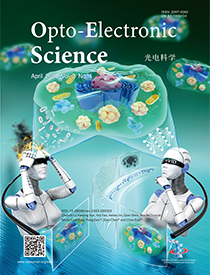2023 Vol. 2, No. 4
Cover story: Li ZS, Sun JS, Fan Y, Jin YB, Shen Q. Deep learning assisted variational Hilbert quantitative phase imaging. Opto-Electron Sci 2, 220023 (2023).
Digital holographic microscopy (DHM) is a typical quantitative phase imaging method, in which the entire complex wavefront information is interferometrically encoded as a fringe pattern (so-called hologram) and then quantitatively demodulated by fringe analysis techniques. By virtue of real-time, high-precision, and high-robust imaging features, DHM has emerged as a valuable means in areas such as biological research, biomedical examination, medical diagnosis, etc. Limited by the interferometric configuration and holographic demodulation scheme, single-frame high-SBP imaging has always been pursued in digital holographic quantitative phase imaging research. The slightly off-axis DHM optimizes the system's SBP by reducing the spatial carrier frequency of the hologram while achieving single-frame fringe demodulation. However, it is still plagued by severe imaging artifacts due to the unavoidable spectral overlapping issue of auto-correlation and cross-correlation terms. Recently, the group of Prof. Qian Chen and Prof. Chao Zuo at Nanjing University of Science and Technology and Prof. Peng Gao at Xidian University reported a deep learning-assisted variational Hilbert quantitative phase imaging technique. Through a data-driven model-assisted physical model, the high-precision artifact-free phase information can be recovered from a single-frame low-carrier frequency hologram using only a small fraction dataset. The proposed residual compensation idea not only solves the time-consuming and laborious acquisition issue of massive datasets, but also can be extended to diverse deep learning-based computational imaging techniques in the future.

-
{{article.year}}, {{article.volume}}({{article.issue}}): {{article.fpage | processPage:article.lpage:6}}. doi: {{article.doi}}{{article.articleStateNameEn}}, Published online {{article.preferredDate | date:'dd MMMM yyyy'}}, doi: {{article.doi}}{{article.articleStateNameEn}}, Accepted Date {{article.acceptedDate | date:'dd MMMM yyyy'}}CSTR: {{article.cstr}}
-
{{article.year}}, {{article.volume}}({{article.issue}}): {{article.fpage | processPage:article.lpage:6}}. doi: {{article.doi}}{{article.articleStateNameEn}}, Published online {{article.preferredDate | date:'dd MMMM yyyy'}}, doi: {{article.doi}}{{article.articleStateNameEn}}, Accepted Date {{article.acceptedDate | date:'dd MMMM yyyy'}}CSTR: {{article.cstr}}

 E-mail Alert
E-mail Alert RSS
RSS


